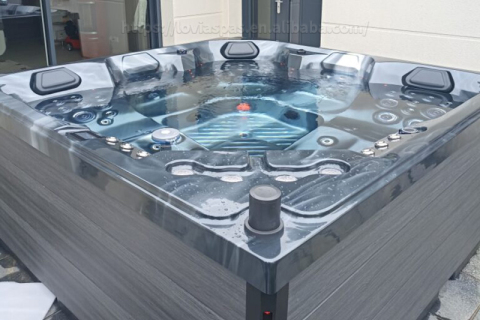
- Home
- >
News
Unlike built-in bathtubs, freestanding whirlpool bathtubs are not fixed to the wall, but rely entirely on the support frame at the bottom of the bathtub to maintain stability. The support frame is usually made of metal or high-strength plastic and has sufficient load-bearing capacity to ensure that the whirlpool bathtub will not tilt or tip over.
If you choose to place a whirlpool bathtub on concrete paving tiles, the first consideration is to ensure a stable foundation. In order to improve the bearing capacity and stability of the ground, it is usually necessary to add a solid foundation to the bricks.
Power supply problem is one of the common reasons why outdoor whirlpool tubs cannot start. If the power supply to the whirlpool tub is out of power, the entire device will not work properly. Users first need to check the power outlet, switch and circuit fuse to ensure that the power supply is normal.
The bathtub's filtration system will work for 30 minutes to 1 hour during the impact process to ensure that the water quality meets the hygienic standards. However, the length of the filtration time also depends on the chemical agents used, the type of disinfection system (such as ozone disinfection, ultraviolet disinfection, etc.) and the degree of water pollution.
If you use the whirlpool bathtub frequently every day or every week, the water and air flow in the jets will be more frequent, and the residual dirt will accumulate faster. For frequent users, it is recommended to clean the jets once a month to ensure smooth water flow and avoid clogging.
● Turn off the water supply to the bathtub and make sure the nozzles stop working. ● Drain the bathtub. ● Add about 2-3 cups of white vinegar to the bathtub, start the water pump, and let the vinegar water flow through the nozzle and pipes. ● Start the bathtub pump and let the vinegar water circulate for about 15-30 minutes to ensure that the vinegar water fully contacts the nozzle and the inside of the pipe.
Its working principle involves multiple mechanical and electrical components, which are exposed to the outdoor environment for a long time and are inevitably affected by factors such as weather, temperature changes, and pollutants. Therefore, it does require certain maintenance work to keep it working properly.
The pump system of the whirlpool bathtub is usually equipped with a filter to remove impurities in the water. If the filter is too dirty or clogged, it will also affect the normal circulation of the water flow and cause the pump to not work properly. Regular cleaning and replacement of the filter is an important measure to keep the pump system running normally.
Chlorine will gradually be consumed as organic matter, bacteria, grease, cosmetic residues, etc. in the water react. During use, after the human body enters the bathtub, the sweat, grease, and cosmetics carried on the skin will react with the chlorine in the water, resulting in a decrease in the chlorine concentration.
Advantages of whirlpool bathtubs: 1. Powerful hydromassage function 2. Provide full body relaxation experience 3. Improve sleep quality 4. Versatility and personalized experience 5. Health therapy effect Disadvantages of the whirlpool bathtub: 1. Expensive and high investment cost 2. Difficult to maintain and clean 3. Loud noise, affecting the bathing experience 4. Large space occupied and high installation requirements 5. Possible safety hazards
Outdoor whirlpool tubs usually have multiple water flow intensity settings. In high-intensity mode, the speed and pressure of the water flow are large, so the water flow noise generated is relatively large. If a lower water flow intensity is selected during use, the sound of the water flow hitting the bathtub and the air mixing will also be reduced accordingly.
Differences between Jacuzzi Tub and Whirlpool Tub: 1. Differences in design and function 2. Differences in technical details 3. Differences in user experience 4. Differences in maintenance and upkeep 5. Differences in price and market positioning












